Manuscript accepted on : 27-11-2023
Published online on: 12-12-2023
Plagiarism Check: Yes
Reviewed by: Dr. Sachchidanand Tewari
Second Review by: Dr Biswajit Batabyal
Final Approval by: Dr. Eugene A. Silow
Department of Zoology St. Aloysius College Jabalpur M. P. India.
Corresponding Author E-mail: drmeghatiwari21@gmail.com
DOI : http://dx.doi.org/10.13005/bbra/3191
ABSTRACT: Tobacco is a perennial herb and its belong to family Solanaceae. Tobacco leaves have some antimicrobial substance such as alkaloids, phenol and some essential oils. The leaves extract of this plant show some microbial Quality and influence on both gram positive and gram negative bacteria. The aim of this work to determine the effectiveness of tobacco (Nicotiana tabacum) leaves extract in inhibiting on Aeromonas hydrophila and Escherichia coli. The antibacterial test performed on Mueller Hinton Agar (MHA) media. Test result indicate the leaves extract of tobacco showed positive result in Aeromonas hyrdophilla. Tobacco extract can inhibit Aeromonas hyrdophilla growth and a clear zone are found, in case of E. coli it showed negative result in both the cases. Tobacco extract cannot inhibit E. coli growth and the diameter of the inhibitory zone is not clear. The result shown that tobacco leaf extract can be source of an active antimicrobial substance.
KEYWORDS: Aeromonas hydrophila; E coli; Tobacco extract
Download this article as:| Copy the following to cite this article: Dixit M, Tiwari M. Study of Antimicrobial Quality of Tobacco Leaves Extract (Nicotiana tabacum) on Aeromonas hydrophila and Escherichia coli. Biotech Res Asia 2023;20(4). |
| Copy the following to cite this URL: Dixit M, Tiwari M. Study of Antimicrobial Quality of Tobacco Leaves Extract (Nicotiana tabacum) on Aeromonas hydrophila and Escherichia coli. Biotech Res Asia 2023;20(4). Available from: https://bit.ly/48hQi2J |
Introduction
India is known for its Rich biodiversity region and have 91,000 animal’s species and 45,000 plant species. As aqueous extract of medicinal plant has potential for antimicrobial activity for various microorganism1 .Tobacco is one of the perennial herbs and its belong to family Solanaceae. In total sixty species of Nicotiana few are homegrown to Australia, America in which Nicotiana tabacum, is use for commercial production. Exposure of Tobacco caused cancer and many disease in human but one of the good thing of Tobacco leaves have some antimicrobial substance such as alkaloids, phenol and some essential oils. The medicinal value of tobacco plant is known to 1492 to till now. Tobacco tea was used to kill intestinal worms, as well as for headaches, and used as an antiseptic. Tobacco in known for cigarette smoking and it is continuing common practices in our society and it causes blood coagulation and increase cardiovascular disese2. The leaves extract of this plant shows some antimicrobial Quality and influence on both gram positive and gram-negative bacteria.
Nicotine is the most important and active substance in tobacco product but clinical value is limited because it causes multiple negative effect. In many study it is found that nicotine has microbial viability on microbes and inhibitory effect on the growth of some microbes such as Aeromonas hydrophila and E.coli .
Aeromonas hydrophila is a gram-negative pathogen and usually found in fresh and brackish water. It cause many water born, intestinal and diarrheal disease in humans and also it infect animals such as fish ,Amphibians and mammals3. Escherichia coli is another gram-negative pathogen causes urinary tract infection and acute enteritis diarrhea. It is found in the food, environment and intestine of animals. At present our study show direct effect of Nicotine on microbes and it shows inhibitory effect. Tobacco extract can inhibit Aeromonas hyrdophilla growth. In case of E. coli, it showed negative result in both the cases.
Material and Method
Collection of samples
The Study conducted at the St. Aloysius College (Autonomous) Lab Jabalpur from January 2022 to May 2022. Tobacco leaf used for this research were obtained from local retailers at Adhartal market in Jabalpur state M.P. and identified at the Department of Zoology of St. Aloysius’ College Jabalpur M.P., for removal of soil and dust particles the sample was wash with tap water and then again with distil water.
Preparation of extracts
Extract was prepared by weighing 50 grams of the homogenized leaf samples and 50 grams of the grounded snuff then it extracted with 500 ml of methanol using Soxhlet apparatus at 80℃. After the extract was made it was collected in a sterile airtight glass bottle.
Preparation of media and plates
3.8 gm of Mueller Hinton Agar (MHA) powder diluted in 100ml of distilled water. Dissolve all components by heating and continuous stirring. Autoclave the dissolved mixture at 121 degrees Celsius for 15 minutes. The dissolved agar has been autoclaved, allowed to cool but not solidify. Pour MHA into each plate and leave plates on the sterile surface until the agar has solidified. Replace the lid of each Petri dish and store the plates in a refrigerator.
Cultures used
Aeromonas hydrophila and E. coli used as a test sample. For this purpose, culture obtained from Department of Zoology and Department of Microbiology of St. Aloysius’ College respectively.
Inoculation
The inoculation was done by two methods streak plating technique and pour plating technique.
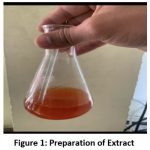 |
Figure 1: Preparation of Extract
|
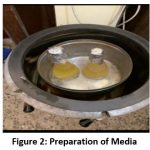 |
Figure 2: Preparation of Media
|
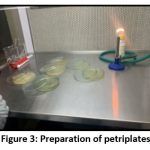 |
Figure 3: Preparation of petriplates
|
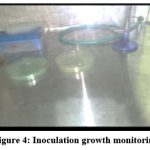 |
Figure 4: Inoculation growth monitoring.
|
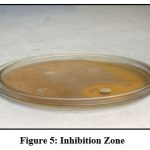 |
Figure 5: Inhibition Zone.
|
Result and Analysis
Results of the present study are presented in the following tables (Table1 & Table 2). We use Aeromonas culture plate to study the antimicrobial effect of tobacco extract.
Antimicrobial Effect of nicotine on Aeromonas hydrophila
The Result showed that tobacco leaves could inhibit the growth of Aeromonas hydrophila and E. coli. The study was conducted in replicates. Fresh cultures of respective pathogens were streaked over the surface of Mueller Hinton agar plates. 1 mg/ml extract was filled up of each well and well with solvent used as a negative effect. The plates were incubated at 37°C for 24 hours the results of the present study indicated antibacterial activity of tobacco leaves extract. The area of inhibition zone around the well were observe. Present study indicates the antimicrobial activity of tobacco leaves on Aeromonas hydrophila.
Table 1: Antimicrobial Effect of nicotine on Aeromonas hydrophila
|
S.No. |
Name of Extract |
NAME |
Description |
|
1 |
Methanol |
Media |
Mueller Hinton Agar |
|
2 |
Culture used |
Aeromonas hydrophila |
|
|
3 |
Extract used |
2ml |
|
|
4 |
Zone of Inhibition |
Zone Visible |
|
|
5 |
Antibiotic (Streptomycin) |
Clear Zone Visible |
Antimicrobial Effect of nicotine on Escherichia coli
Extract of tobacco leaves does not have antimicrobial activity for E. coli and the diameter of the inhibitory zone is weak in comparative to Aeromonas hydrophila.
Table 2: Anti-Microbial Assay of Nicotiana tabacum on Escherichia coli
|
S.no. |
Extract |
Name |
Description |
|
1 |
Methanol
|
Media |
Mueller Hinton Agar |
|
2 |
Culture used |
E.coli |
|
|
3 |
Extract used |
2ml |
|
|
4 |
Zone of Inhibition |
Zone Not Visible |
|
|
5. |
Antibiotic (Streptomycin |
Clear Zone Visible |
Discussion
The antibacterial activity of tobacco leaves extracts against Aeromonas hyrdophilla (Gram positive) and E coli (Gram negative) was measured by evaluating the diffusion method in agar.
Study performed by Anumudu CK et al2019 showed that the methanol extract of tobacco leaves has great antimicrobial activity4. According to Sofi Mohmmad Ashaq et al 2022 Organic solvents such as methanol, ethanol, acetone has bioactive compound5.The Present study exhibited that, methanol extracts of the Nicotiana tabacum showed antimicrobial activity in different test organisms. Same result was found by K.P. Singh et al 20106.
According to Nunes &Miguel 2017, Syadza Firdausiah et al , 2020 Tobacco leaves extract contain alkaloids, Phenol, terpenoid, flavonoids, Tannin compound, but did not contain Saponin7. According to A. Prommaban et al 2022 ethanolic extract of tobacco leaves has higher percentage of phenolic compounds than petroleum ether extracts8. The ability of these tobacco leaves extracts to inhabit the growth of Aeromonas hydrophila is due to presence of these secondary metabolites. Flavonoids Inhabit bacteria by produce of complex compound, Tanin react bacteria and inhabit the bacterial growth. Alkaloid compounds also inhabiting bacterial cell by disrupting the peptidoglycan.
In our study Escherichia coli. (gram negative ) is a another test organism. In case of E.coli it showed negative result in both the cases. Tobacco extract cannot inhibit E.coli growth and the diameter of the inhibitory zone is not clear.
In recent study the result shown methanol leaves extract of tobacco are less effective in gram negative bacteria and it is very effective in gram positive bacteria9. The inhibition zone was clearer in gram positive bacteria may be due to the structure of cell wall is simpler as comparative to gram negative bacteria. The cell wall of gram-negative bacteria are more complicated so tobacco leaves extract not able to effect this cell wall and zone of inhibition is not cleared. This result is similar to the earlier study S A Fernanda et al 202110. Earlier research have found that many phytocompounds present in medicinal plants are active agents for treatment of many disease caused by microbes and formulation of new drugs.11
Conclusion
The present study shows that the methanol extract of tobacco leaves proves to be better in antimicrobial properties as compared to water extract. In recent study shows that methanol leaf extracts tobacco showed positive result in Aeromonas hyrdophilla as compare to E coli. Present study indicate that tobacco leaves extract can be used as a source of antimicrobial compound for drug development and control of some bacterial agent.
Acknowledgement
We thank Department Of Zoology and Department of Microbiology of St. Aloysius College Aloysius (Autonomous) for their support.
Conflict of interest
There is no conflict of interest for the article.
Funding Sources
There are no funding sources for this work.
References
- Rajiniraja M., Sundararajan Sadhana,et al Antimicrobial and Antimycobacterial Properties of Solanum Trilobatum L. – invitro Research Journal of Pharmacy and Technology. 2022 215(12).
- Benowitz, N.L., Gourlay, S.G.et al Cardiovascular toxicity of nicotine:implications for nicotine replacement therapy.Journal of the American College of Cardiology 1997,29( 7) 1422-1431.
CrossRef - Seshadri R., Joseph S.W., Chopra A.K., et al ,Genome sequence of Aeromonas hydrophila ATCC 7966 T : jack of altrades J Bacteriol. 2006, 188(23): 8272–8282.
CrossRef - Sofi Mohmmad Ashaq et al. Phytochemical profiling of the Methanolic root extract of Lavaterà cashmeriana using GC- MS and Evaluation of its Potential Antimicrobial Activity 2022, 15(12) 5707-5713).
CrossRef - Anumudu et al., Antimicrobial activity of Extract of tobacco leaves and its grounded snuff(utaba)of candida albicans and streptococcus pyogenes J Trop Dis 2019, 7:2
- Singh K.P.,Daboriya V., Kumar S., Singh S. et al Antibacterial activity and phytochemical Investigations on nicotiana plumbaginifolia viv. Tobacco Biol. – plant biol., 2010 55(2), 135–142,
- Kekuda P., Raghavendr Tr, Avinash et al Insecticidal, antibacterial, and antiradical activity of nicotiana plumbaginifolia viv. (solanaceae) 2017, 11 20559.
- Nunes, Miguel, Syadza Firdausiah et al , The Comparison of Three Different Methods on Extraction of Cigarette Butt as Natural Insecticide.2020, 11812.
- Adchara P., Kantaporn K. , Chittasupho C. et al Phytochemical, Antioxidant, Antihyaluronidase, Antityrosinase, and Antimicrobial Properties of Nicotiana tabacum L. Leaf Extracts. Hindawi Evidence-Based Complementary and Alternative Medicine
CrossRef - Fernanda S.A. et al Antibacterial Potential of Nicotiana tabacum L. var VirginiaPyrolysis Extract Against Staphylococcus aureus, Enterococcus/faecalis, Escherichia coli, and Pseudomonas aeruginosa, IOP Conf. Ser.: Earth Environ.2021, 755 012013.
CrossRef - Mishra D., Sahu S., Mukherjee A., Akanksha Rai et al International Journal of Advances in Science Engineering and Technology. 2018, 6 (4), 2321 –9009

This work is licensed under a Creative Commons Attribution 4.0 International License.





